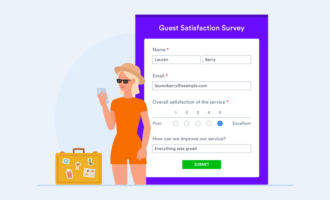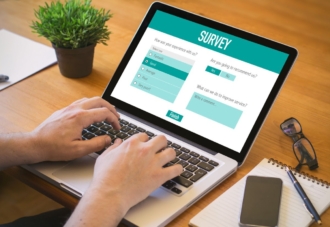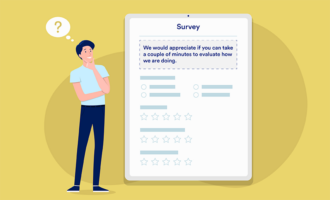Not taking cybersecurity seriously can have major consequences: In 2022, each cybersecurity data breach cost an eye-popping $9.44 million on average.
And while a financial loss of that size can be devastating to many organizations, money isn’t the only issue. Companies also suffer a loss of reputation and trust among their customers, employees, and partners. After all, who wants to work with an organization that can’t keep data safe?
To help avoid this fate, you need a robust cybersecurity strategy in place. One small but important part of this strategy is the cybersecurity questionnaire, which can help your organization identify weaknesses in its network and actively work to shore them up.
In this article, we’ll look at cybersecurity questionnaires in more detail, including some best practices for creating this kind of tool and example questions to include in your own cybersecurity questionnaire. Plus, we’ll introduce you to a highly secure software tool you can use to easily create, send, and manage them.
The basics and benefits of a cybersecurity questionnaire
A cybersecurity questionnaire is a tool an organization uses to identify cybersecurity vulnerabilities and threats, assess risks, and determine solutions and protections.
While businesses typically give cybersecurity questionnaires to prospective vendors to gauge the quality of their security practices, you can also use them with customers or even with employees. A cybersecurity questionnaire for vendors may focus on the vendor’s security protocols and infrastructure, while a questionnaire for customers would deal more with connectivity or virtual private networks. A cybersecurity questionnaire for employees might focus on access control and password use.
The questions in a cybersecurity questionnaire could cover a number of different areas, including
- Internal security policies
- Security laws and regulations
- Compliance enforcement
- Data privacy
- Access control
- Data center security
- Web application security
- Cybersecurity education
- Change management
Cybersecurity questionnaires could also cover elements such as business continuity policies and resilience management to ensure there’s a plan of action should a cyber incident occur.
Best practices for cybersecurity questionnaires
To get clear, accurate, and useful information, consider the following tips as you create your cybersecurity questionnaire.
1. Customize the questionnaire for the intended audience
It can be tempting to use the same cybersecurity questionnaire with everyone; however, it’s important to customize the questions according to who you’re sending the questionnaire to.
For example, a questionnaire for vendors should focus on their security protocols and access controls; one for employees should ask questions that will reveal their knowledge of cybersecurity practices and password management.
2. Establish a clear goal for the cybersecurity questionnaire
Determine specifically what your organization needs to know from your audience to support your cybersecurity protocols and design the questions around that goal.
For example, if you want to understand the potential threats you might be exposed to in working with a new vendor, ask about their history of cybersecurity, their most pertinent vulnerabilities, the compliance standards they follow, and other related questions.
3. Follow data compliance standards for cybersecurity questionnaires
You don’t have to reinvent the wheel. Start with established cybersecurity questionnaires that reputable organizations have developed and build upon them to meet your needs. Examples of these organizations include
- National Institute of Standards and Technology (NIST)
- The Consensus Assessments Initiative Questionnaire (CAIQ)
- CIS Critical Security Controls
- Standardized Information Gathering (SIG)
4. Cover a number of cybersecurity topics
Cybersecurity is a multifaceted field that involves multiple layers of safeguards and strategies. That’s why it’s best to cover multiple risk assessment methods in your questionnaire, such as encryption; security standards like SOC 2, CCPA, and HIPAA; security ratings; and more.
5. Ask for additional information if you need it
While the questionnaire may give you a solid understanding of the potential risk exposure overall, some answers may require further investigation. Don’t hesitate to follow up with a respondent to gather more information until you feel satisfied with the answers they’ve provided.
6. Remember that security questionnaires aren’t enough on their own
A cybersecurity questionnaire is an excellent way to learn more about potential threats, but it’s just a small part of your security strategy. You have to act on the information you gather and ensure you have protocols in place to minimize threats and strengthen any vulnerabilities.
7. Use a questionnaire software
Make it easy on yourself and your respondents by avoiding the hassles that come with hard copies and emails. Instead, opt for a software that’s designed to streamline the process.
Questionnaire software comes with cybersecurity survey templates you can edit according to your needs. They also offer easy ways to distribute the questionnaires, such as through email, QR code, or text. Plus, many of these solutions have tools to analyze the responses and create reports from the findings.
Of course, when you’re using any third-party vendor, be sure to learn about their security protocols, too!
Example cybersecurity questions
Here are 15 sample cybersecurity questions you may want to include in your questionnaire:
- What security certifications do you hold?
- What industry security regulations, such as GDPR or HIPAA, do you adhere to?
- How often do you review your access control policy?
- How do you notify customers, partners, and vendors about security breaches?
- What type of background checks do you perform on employees?
- Is your data encrypted at rest and in transit?
- Are your system backups encrypted?
- Do you require multifactor authentication?
- What is your password creation and change policy?
- Do you conduct cybersecurity training for all of your employees?
- What types of confidential or private information do you collect?
- What is your business continuity plan if a cybersecurity breach occurs?
- Do you use the principle of least privilege for access control?
- How do you dispose of data you no longer need to store?
- What is your incident management program?
Jotform: A powerful tool for cybersecurity questionnaires (and more!)
If you’re looking for an easy, highly secure solution for creating, distributing, and managing cybersecurity questionnaires, look no further than Jotform.
This survey maker comes with templates for cybersecurity questionnaires and cybersecurity checklists that you can easily customize according to your needs. Use the drag-and-drop editor to alter the text, structure, and visuals of the questionnaire so it aligns perfectly with your organization’s goals.
Security is paramount for Jotform, just as it is for your company. With features such as 256-bit SSL encryption, Google reCAPTCHA, password protection, PCI compliance, features that help with HIPAA compliance, and much more, Jotform ensures that all of your data remains in the right hands.
And if you need forms for other types of surveys or processes, Jotform has you covered there, too. Jotform comes with templates for thousands of use cases, from human resources and payroll to IT and more. Our spreadsheet-powered database, Jotform Tables, is perfect for analyzing your form responses, and Jotform Report Builder makes it easy to create visual reports. Jotform even integrates with multiple payment processors so you can collect payments with your forms.
Get started with Jotform today by signing up for an account.
Photo by Ling App






































































































Send Comment: